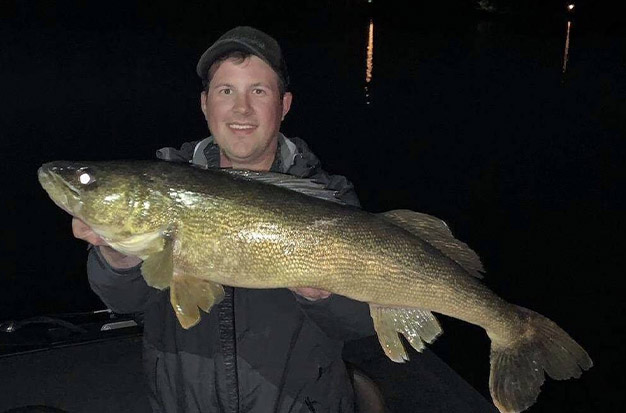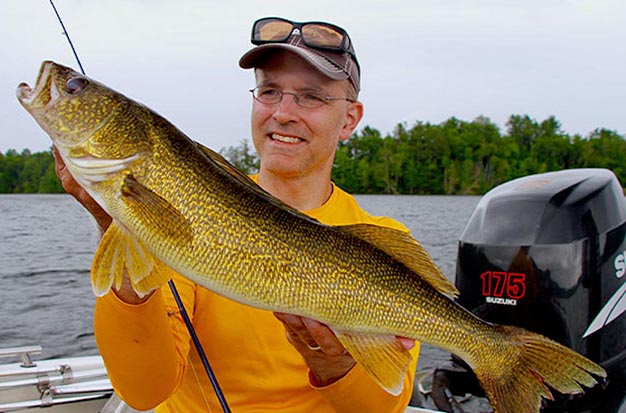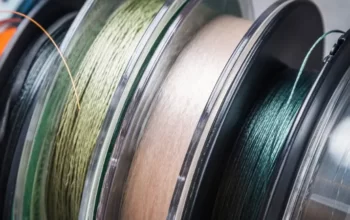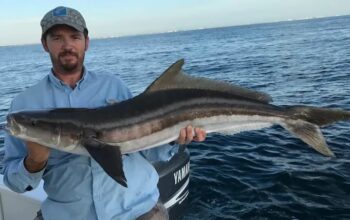Do you know how to catch walleye?
With a preference for cool waters where they can grow to impressive sizes, walleye are widely distributed throughout the United States. The largest specimens can grow to over 25 inches and 10 pounds in many locations.
Although they are technically members of the perch family, walleye are sometimes referred to as yellow pike or wall-eyed pike in some parts of the country. Regardless of the name you give them, these fish are highly sought after.
Walleye are among the most flavorful freshwater fish, in addition to being tough fighters.
Walleye may appear enigmatic, difficult to find, and even more challenging to catch to some people. But these fish actually follow clear, simple patterns that, with the right tools and a little expertise, anyone who wants to catch them can achieve.
Table of Contents
Walleye Basics
Walleye, or Sander vitreus as they’re known to science, are a cool water predatory species common to much of the northern U.S and Canada. Sporting a beautiful olive-gold color, the walleye is long-bodied and sleek, explaining why its close cousin, the European zander (Sander lucioperca), is known as the pikeperch.
Like most fish, walleyes have a fairly consistent relationship between their length and weight, with females typically being larger than males. The weight of 20-inch eyes is approximately 3.3 pounds. In contrast, a 25-inch eye would weigh the most at roughly 6.35 pounds.
As you can see, a little bit longer is unquestionably heavier!
Larger specimens have been documented, but they are extremely rare, typically reaching a maximum of about 30 inches and 20 pounds. In fact, when Mabry Harper brought a 25-pound brute to shore in 1960, he set the tackle record for walleye.
Because their eyes are positioned outward, walleyes get their name. They have particularly keen vision and are well-adapted to low light and murky water. Additionally, they have sensitive lateral lines.
Behavior of walleyes is affected in every way by this.
Walleye prefer to swim in search of food rather than wait in ambush for prey because they can see clearly in low light and detect vibrations from a great distance away. Additionally, they frequently feed when it is difficult for other fish to see them, such as at dusk or at night, in murky or stained water, on cloudy days, or when the wind is whipping up “walleye chop” on the water’s surface.”
Therefore, fishing in low light while locating the prey items that will draw these predators is the key to catching more walleye. You’ll see walleye cruising close by when you come across their prey.
When Can You Catch A Walleye?
For successful walleye fishing, timing is everything.
The time of day has a significant impact on walleye behavior and movement in addition to the seasonal patterns that they follow. Planning your upcoming walleye fishing trip requires an understanding of both.
Best Time Of Day
More than any other game fish, walleye can see in the dark because they have some of the most light-sensitive eyes in the freshwater fish kingdom.
Many seasoned walleye anglers are of the opinion that the best time to catch them is late at night.
The best walleye fishing generally occurs during low-light conditions, when it is neither fully light nor fully dark.
It’s a great idea to be out on the water in the evening as the sun is setting, and the hours from sunup to sundown can be equally fruitful.
It goes without saying that a bright, sunny afternoon is the worst time to catch walleye.
Although it’s not impossible, walleye prefer deep water and shade to avoid the hot sun. Because of this, you’ll need to modify your fishing locations and techniques.
Seasonal Movements
All fish follow recognizable patterns of movement that are influenced by the cyclical nature of the seasons. But compared to other freshwater game fish, walleye movements may be even more closely tied to calendar changes.
Finding fish is frequently simpler than one would think once one has a basic understanding of how seasonal changes affect walleye patterns. Of course, finding and catching are two entirely different things, as we all know!
Spring
You could say that the spring is the “busy season” for walleye fishing.
Walleye primarily think about two things as the water starts to warm up in late winter and early spring: eat and reproduce.
To achieve both objectives, walleye migrate to shallow water in the early spring. In most lakes, walleye are among the first fish to do so.
Walleye hide out in deep areas close to spawning sites during the pre-spawn period. Walleye move into the shallows once the water has warmed up enough—they usually spawn when it is between 45 and 48 degrees.
If available, walleye migrate up rivers and tributaries to spawn; if not, shallow rock beds and gravelly reefs will do.
When spawning is finished, walleye return to their deeper haunts, often exhausted and feeding ferociously to make up for the effort of spawning.
The walleye spawn ends as the yellow perch spawn starts in many lakes and reservoirs, and during this time, the walleye frequently eat a lot of perch.
Summer
Most walleye develop a dependable pattern of feeding heavily in developing weed beds, rocky reefs, and other shallow to mid-depth structures by late spring.
Walleye typically spend the sunny hours of the day in nearby deep waters before emerging at dusk to move toward shallow feeding grounds, where they may spend the night.
Even though walleye typically follow the same late spring/early summer patterns as the summer progresses, they typically slow down and feed less actively.
Even though walleye are less likely to put forth as much effort to obtain a meal in the summer, they will still bite. The most effective presentations are usually those that are slow and natural.
The best spots for summer walleye fishing are frequently rocky ledges and drop-offs into deep water. Another location where you might find fish is the deeper edge of a weed bed, rock pile, or reef.
These areas are frequented by walleye holding just off the bottom while they await their prey.
Fall
Fall is a season of change and transition for walleye, just like it is for most fish species.
These fish become more active during this time, almost as if they can sense the impending winter and are eager to stock up on food.
In the fall, a number of things occur that are beneficial to walleyes.
Prey fish are exposed as summer weed beds start to disappear. The amount of time each day that walleye can comfortably hunt in shallow water increases as the days grow shorter and the water temperature starts to drop.
Fall is the only season where walleye are more active during the day.
Of course, shrewd anglers can also benefit from these changes.
During the fall, the best fishing is found along the deeper edges of weed beds, reefs, rock piles, humps, and transitional zones between deep-water haunts and shallow hunting grounds.
Winter
For walleye, winter means a slow crawl through life.
But in contrast to popular belief, these fish are very active. Walleye still need to eat, they just aren’t willing to put in as much effort to get a meal.
Walleye typically hold in deep water in the early winter, around the time that the first safe ice begins to form, but not too far from drop-offs and other significant structural features.
The deep end of a drop-off or rocky point is a popular spot for walleye to suspend, and if possible, they’ll pick a spot where they can set up shop below a school of forage fish.
Deep water areas that are accessible from shallow water are still crucial during most seasons.
By the end of the winter, walleye start to migrate toward staging areas close to spawning grounds in the spring. Frequently, they do this before the ice has completely melted.
After the ice melts, tributaries, gravel bars, and areas close to rocky shorelines become crucial.

Where Can I Catch Walleye?
Walleye are indigenous to Canada and a sizable portion of the northern United States.
The walleye’s native range, which includes the Ohio, Missouri, and upper Mississippi River basins, is centered on the Great Lakes and their tributaries.
Walleye now live in lakes, rivers, and reservoirs far outside of their original range due to introductions made all over the world.
Walleye can be caught all the way from Texas in the south to Washington and Oregon in the west, where the Columbia River system has made them a thriving species.
But regardless of where you are in North America, there are a number of striking similarities between the kinds of waters walleye prefer to live in and the methods you can use to catch them.
Walleye Fishing In Lakes And Reservoirs
Walleye thrives best in large lakes.
Farm ponds and backwaters are not good habitats for these fish. They require an abundance of forage opportunities in a variety of habitats and deep, cool, preferably clear water.
Because of this, walleye thrives in the Great Lakes and other sizable natural lakes that are prevalent in states like Minnesota.
But because man-made impoundments frequently mimic the best natural walleye lakes’ ecosystems, these fish have evolved to thrive in huge reservoirs.
Many of the factors that support walleye growth can be found in these artificial bodies of water: rocky habitat, cool water, abundant forage and great variations of depth, usually with steep drop-offs.
The difficulty of fishing a large lake—especially an unfamiliar lake—is that there is such a great deal of potential walleye habitat available. Finding fish may become challenging as a result.
Trolling is typically the best place to start because you need to find the walleye. With crankbaits, worm harnesses, or bottom-bouncer rigs, trolling along a drop-off is a great way to quickly cover a lot of water in search of fish.
When you find a school, you can cast jigs and crankbaits to further investigate that particular area.
A great method for catching walleye in lakes and reservoirs is to cast live bait, jigs, or crankbaits along rocky banks and the edges of weed beds at dusk or dawn when the fish are most active in shallower water and feed.
Walleye Fishing In Rivers
Even in large, slowly moving rivers, walleye thrive. Major rivers with deep water and lots of rocky structure provide prime walleye habitat, from the St. Lawrence River in the east to the Columbia River in the west.
Most rivers have deep pools or holes where walleye live. The river determines how deep water is considered to be; in some smaller waterways, the deepest available water is only 8 or 10 feet.
Deep pools with a current break—a piling on a bridge, a big boulder, or a downed tree—can be particularly fruitful. Walleye frequently position themselves directly downstream from a break and use these structures as cover from the current.
Like they do in lakes, walleye move into shallow water to hunt in rivers, and they typically do this at dusk. Around dawn and dusk, rocky riverbanks, gravel bars, and flats can produce.
The tailrace areas directly beneath dams and spillways are some of the best locations to find walleye in rivers.
When dam outflows are frequently high in the spring and fish migrate upstream to a spot just below the discharge, tailrace areas can be particularly fruitful.
Walleye Fishing Gear
Use a medium-heavy spinning outfit with 6 to 8 pounds of monofilament fishing line when learning how to fish for walleye. Light line is advised because walleye commonly inhale their prey. When you use light line, the walleye will encounter less drag or resistance when trying to strike your bait or lure. Walleye will be more likely to accept your offering if there is less drag.
Trolling will be an exception to any walleye fishing advice that suggests using light line. Using medium-heavy baitcasting equipment rigged with 10 to 14-pound monofilament may be a good idea if you intend to troll for walleye.
Best Lures For Walleye
Consider the main food sources in the waters where you intend to fish when choosing the best lures to use for walleye. Yellow perch, minnows, crayfish, leeches, and a variety of insects are among the food sources for walleye. When walleye fishing, take into account the use of lures that replicate these kinds of food sources.
- Jigs
- Minnow-imitating plugs
- Spoons
Best Rigs For Walleye
You can find walleye fishing advice that will teach you how to use a slip sinker rig, a slip bobber rig, and a spinner rig in addition to lures. These freshwater fishing rigs are helpful when walleye fishing with live bait because they keep your baits off the bottom and in the strike zone.
- Slip sinker rig
- Slip bobber rig
- Spinner rig
Best Walleye Fishing Spots
The only thing left to do is figure out where to catch a walleye now that you are aware of some of the best freshwater fishing equipment and lures to use. It will be useful to keep in mind that walleye are coolwater fish when choosing where to fish for his species. As a result, it may be best to stick to large, unpolluted lakes or rivers with water temperatures that typically range from the low 60s to the low 70s when learning how to fish for walleye.
- Lake of the Woods in Minnesota, Lake Winnebago in Wisconsin, Devils Lake in North Dakota, and the Detroit River in Michigan are a few locations where walleye fishing is popular.
- Walleye are frequently found nearby structures, like the majority of fish species. A good place to fish is close to weed beds, humps, points, and ledges.
Techniques On How To Fish For Walleye
You are now aware of the location of the Walleye and the tackle required to catch them. Put some tried-and-true methods to use with your bait and tackle. The following techniques should be carried out in accordance with your choice of tackle and the water characteristics you have noted.
Jigging Live Bait
Jigging is the practice of presenting your bait close to the bottom with lifts, drops, and pauses in order to entice a bite. When walleyes are actively feeding on dense structure like points in the spring, this strategy is most successful. If you’re jigging from a boat, keep your bait in front of you so you can precisely determine your distance from the bottom as your boat drifts or slowly trolls over an area. Ensure that you can feel the ground and bounce your jig along every 3 to 5 seconds, lifting one foot, lowering it, and then pausing on the bottom for a short period of time. By casting your bait and jigging it back on the retrieve, you can jig from a dock or the shore. When fishing from shore, you should typically aim for rocky, sandy, or along the weedline. Jigging from the shore can be difficult if there is too much vegetation; if this happens, switch to a Slip Bobber.
Jigging Plastics
Ideal when looking for fired-up Walleye in the fall or in rivers with strong currents. When you’re jigging plastics, you’re trying to cover a lot of water while casting and looking for walleyes. Try throwing your soft plastics that are attached to jig heads and bounce, drag, or swim them back along the bottom. Try a variety of different actions, varying cadences and pauses, but always keep your lure a foot or two off the bottom in the strike zone. Keep moving and looking, and read In-Fisherman’s Article for more sophisticated methods and plastics.
Drifting
This is how Live Bait Rigs are moved along the bottom. When Walleyes are timid in late spring and early summer due to unfavorable conditions or when they are sluggish in the early spring spawn, drifting live bait is the best option. A Walleye Chop or winds just strong enough to create waves that are less than a foot high are ideal. On favorable days, Walleye Chop can propel your boat at a speed of 0.2-0.4 MPH. Use a drift sock to slow the roll when the winds are a little stronger. Use a trolling motor on low to achieve the same results if there is no chop. Jigging-style, extend your line out next to the boat while keeping it just a few yards away. The sharper angle will wedge your sinker into rocks if you let out too much line after you reach the bottom. Allow your walking weight to thump against the rocks as you feel the bottom. Instead of a gradual pull or rolling of the rocks against your sinker, a bite feels like a tap-tap-tap instead of a tick feels like a tick.
Float Drifting
The best option for beginners all year round is to drift a Slip Bobber. The best times to use it are in the spring and fall when you can find a school, but you can also use it in the summer during the prime dusk/dawn feeding times. Target a uniform depth zone of 20 yards around the structure you are fishing. Set your slip tie so that your bait is a foot off the bottom and your slip float is upright while you anchor your boat. Let the chop carry your Slip Float through the intended area after casting 5 to 10 yards from the boat. Keep turning your boat around to cover the drifts. Until you start getting bites, anchor up and move to new areas.
Trolling
Trolling, which works best on flat surfaces with a consistent depth, can bring in walleyes on offshore reefs in the summer and on nearby mudflats during the fall mayfly hatch. To spread your offerings out and away from loud motors, trolling is typically done with planar boards. But you can still have success by simply trollng 50 to 100 yards behind your boat. With crankbaits, 1-2 MPH are typical speeds. Spinner rigs frequently operate at speeds closer to 1 MPH. Target depths are typically 10 to 15 feet. so your lures can stay close to the bottom.
Walleye Fishing Takes Patience
It can be difficult to learn how to fish for walleye. They have particular tastes, and many of the slow days are beyond your control. Utilize structure and feeding habits to guide your search for Walleye. Get some fish on the boat by beginning to target them with live bait. You’ll enjoy the challenge a lot more after you learn how to catch a few Walleye. Here are some more advice on walleye fishing from our other experts if that piques your interest.
What To Consider When Walleye Fishing?
The following things to bear in mind:
Low light is king.
Diminished light causes walleye feeding at any time of year. The best times to catch walleye are at dusk and from midnight to dawn. Cloudy days are much more likely to see walleye activity than those with direct sunlight. Many seasoned walleye fishermen know to skip the morning and start fishing for walleye just as the sun is setting because of their superior vision, which gives them a predatory advantage that their prey can’t match.
Any walleye addict will tell you that conditions like overcast days, the 90 minutes immediately preceding dusk, and other situations that interfere with the amount of light that the fish receives will cause them to begin hunting. For instance, “walleye chop,” brought on by a strong breeze, is a major factor in feeding on open water.
But whereas most anglers in search of summer walleye are tempted to troll deep as their go-to technique, these fish follow a predictable daily cycle that brings them to shallows. Walleye emerge from the depths in search of food when it is dark. The majority of the time, you can find them patrolling the edges of living weed beds, small islands, and other structures for smelt, suckers, shad, and other small prey species, such as immature perch.
The midnight to dawn shift will increase your chances of catching true bruisers if you decide to fish even later. Larger walleyes enter the same feeding areas where smaller ones were at dusk after midnight.
Walleye enjoy contrasts. Look for unusual architecture—anything that deviates from the norm.
Wherever bait fish are present, walleye are as well. The walleye can be located by following the ciscoe and shad. Near drop-offs or inflows like creeks and rivers, I like to look for live weed beds, current, and shallows.
Conclusion
Any season is a great time to catch walleye, and with a few unorthodox moves, you can make other anglers envious. The key is to change up the “summer means deep” playbook, adapt your strategy to the seasons, and become knowledgeable about walleye behavior throughout the year.
We would be interested in hearing from you if these suggestions helped you catch more walleye.




